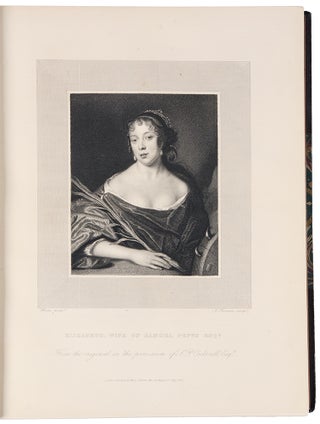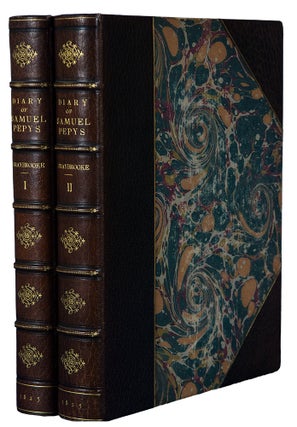PEPYS, Samuel (1633-1703)
Memoirs of Samuel Pepys, Esq. F.R.S., comprising his Diary from 1659 to 1669, deciphered by the Rev. John Smith...from the original short-hand Ms. in the Pepysian Library, and a Selection from his Private Correspondence. Edited by Richard, Lord Braybrooke
London: Henry Colburn, 1825. Large 4to, 2 vols. (11 3/4 x 9 5/8 inches). [2], xlii, 498, [2], xlix; [4], 348, [2], vii, [1], [3]-311pp. Engraved frontispiece in each volume and 11 engraved plates (one folding)., plus a map of the Action at Sheerness with the Dutch Fleet, including a facsimile of Pepys special short-hand, a family tree, and fine portraits of Pepys and his wife Elizabeth.
Three quarter dark green morocco by Zaehndorf, marbled paper boards, marbled endpapers.
A very fine first edition of Pepys' diary.
Samuel Pepys, the Secretary to the Admiralty under Charles II and James II, began keeping a diary at the age of 27 and filled six volumes before ending it nine years later. The diary, originally written in code, was housed in the Magdalene College library until the Rev. John Smith, of St. Johns Cambridge, deciphered it between 1819 and 1822, and it was published in 1825. As a leading official in the admiralty for over a decade, Pepys was in touch with some of the most influential men in government. He also carried on a correspondence with Isaac Newton, Christopher Wren, and John Evelyn. His observations, written in his secret cipher, are one of the best views and principal sources for many aspects of government, intrigue, and social life in the mid-17th century. "To read Pepys is to be transported immediately into his world. His diary is not so much a record of events as a recreation of them. Not all the passages are as picturesque as the famous set pieces in which he describes Charles II's coronation or the Great Fire of London, but there is not an entry which does not in some degree display the same power of summoning back to life the events it relates...Throughout the diary Pepys writes mainly as an observer of people. It is this that makes him the most human and accessible of diarists, and that gives the Diary its special quality as a historical record" (Robert Latham, The Illustrated Pepys). "The Diary is a great work, as literature, as history, as a psychological document and as a key as to what has been known as the English character...It is thus almost impossible to exaggerate its value and importance" (Richard Ollard, Pepys: A Biography, London: Hodder and Stoughton, 1974).
Grolier, 100 Books Famous in English Literature, 75; New Cambridge Bibliography of English Literature, vol. II, col. 1583; Lowndes 1828.
Item #39596
Price: $3,000.00





